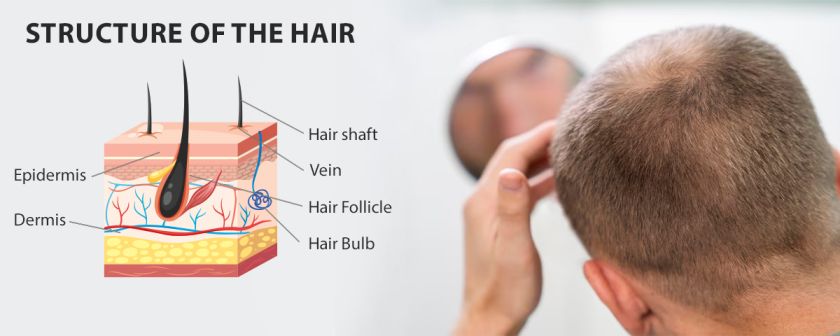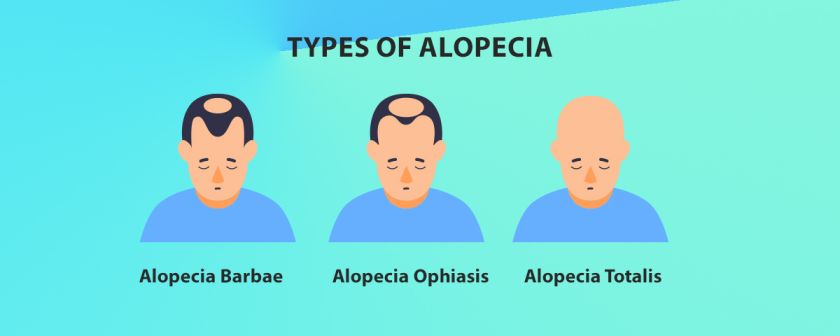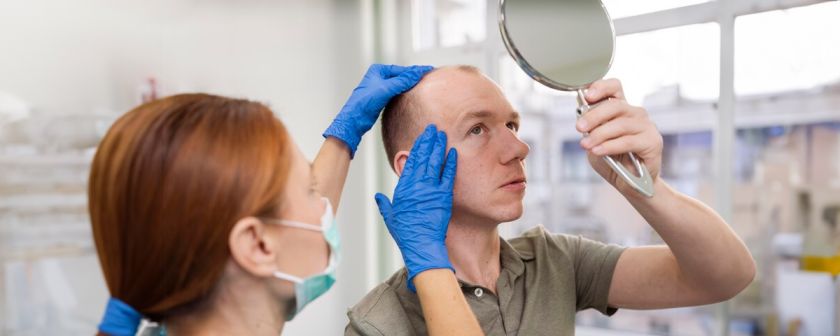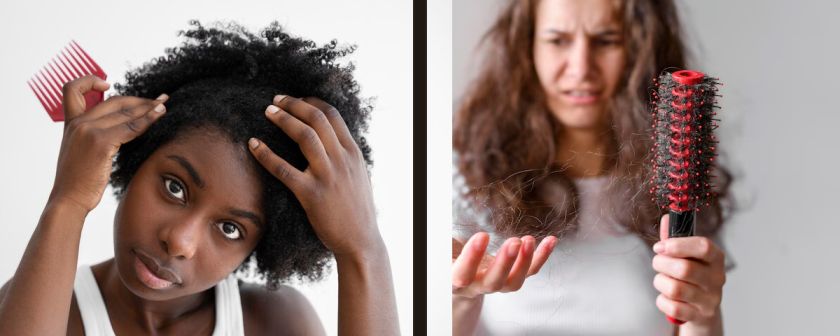介紹
斑禿是一種以突然且不明原因的脫髮為特徵的自體免疫疾病,其認知和治療均已取得重大進展。這種疾病通常表現為頭皮和身體其他部位的斑狀脫髮,反映了自體免疫疾病的複雜性以及在解決此類健康挑戰方面取得的進展。根據國家斑禿基金會 (NAAF) 的數據,全球約有 2% 的人在一生中的某個階段會遇到斑禿。在美國,有近 700 萬人患有、曾經經歷過或將會患上斑禿,全球約有 1.6 億人面臨同樣的情況。斑禿最初被認為是對外表的影響,但人們對其的理解已經擴展到心理和情緒層面。醫學研究和治療方案的進步對於改善受這種疾病影響的人的生活品質至關重要。
透過專家見解和解決方案增強您對斑禿的認識和方法。在 Data Bridge Market Research 探索前沿研究、創新和詳細的市場分析。了解先進的療法如何改善患者的治療效果並促進有效的治療策略。
要了解更多信息,請訪問https://www.databridgemarketresearch.com/reports/global-alopecia-areata-market
探討斑禿的症狀範圍:從鬍鬚斑塊脫落到全身毛髮脫落
- 鬍鬚脫髮
須部禿髮的特徵是斑狀脫髮,特別是在鬍鬚區域。這種斑禿會影響臉部毛髮突然出現局部禿斑的男性。確切原因尚未完全了解,但據信這是針對鬍鬚區域毛囊的自身免疫反應。
- 蛇形脫髮
蛇形禿髮是指頭皮上出現帶狀或條狀脫髮,通常影響頭部兩側和後下部。這種圖案有時會延伸到整個頭皮。蛇形斑禿被認為是斑禿的一種更嚴重的形式,因為它通常涉及更大面積的頭皮並且治療起來更具挑戰性。
- 全禿
全禿是指頭皮上的頭髮完全脫落。與斑禿相比,它代表了斑禿的更晚期階段。全禿患者由於頭皮毛髮完全缺失,會遭受嚴重的情緒和心理影響。
- 普禿
全禿是斑禿中最常見的形式,其特徵是頭皮和全身的毛髮完全脫落,包括眉毛、睫毛和體毛。這種罕見疾病是斑禿最嚴重的表現,會嚴重影響患者的生活品質。其潛在機制仍在研究中,治療選擇有限。根據 2023 年 3 月《JAMA Dermatology》發表的一項研究,在 1,093,176 名符合條件的患者中,有 1,812 名至少被診斷出一次患有斑禿 (AA)。約 9% 的確診患者患有全禿或普禿。
斑禿常見的患處和症狀
受影響區域:斑禿主要影響頭皮,但也會導致身體其他部位的掉髮。這些領域包括:
- 臉部:鬍鬚或鬍鬚區域可能發生脫髮
- 胸部:胸部可能會出現斑塊狀脫髮
- 背部:背部可能會出現局部或大面積掉髮
- 手臂:手臂上的毛髮可能會變薄或脫落
- 腿部:掉髮也會影響腿部
脫髮模式可能有很大差異。有些人可能只在幾個特定區域出現脫髮,而其他人則可能在多個區域出現脫髮。掉髮的速度也是不同的;對某些人來說,這種情況發生得很快,而對其他人來說,這種情況進展得較慢。
其他症狀:
- 搔癢或灼熱感:常見症狀是脫髮部位出現搔癢或灼熱感。這種感覺可能在脫髮之前或伴隨脫髮出現
- 灰色或白色頭髮:在某些情況下,脫落的頭髮開始重新生長時可能會被灰色或白色頭髮取代
- 指甲變化:斑禿也會影響指甲,導致指甲表面出現凹陷(小凹痕或凹陷)或病變
增加斑禿風險的因素:了解遺傳和健康之間的聯繫
斑禿是一種自體免疫疾病,免疫系統錯誤地瞄準並攻擊毛囊,即負責毛髮生長的結構。在某些情況下,它也會影響指甲。這種錯誤的免疫反應會導致掉髮,可能發生在身體任何長有毛髮的部位,如頭皮、睫毛、眉毛、手臂或腿。
有多種因素會增加斑禿的可能性,包括:
- 家族史:近親患有斑禿會增加罹病風險
- 氣喘:氣喘患者可能更容易罹患自體免疫疾病
探索全球氣喘疾病市場的最新創新。發現旨在有效管理和治療氣喘症狀的先進解決方案和療法。透過深入的見解和最新的治療方案來獲得競爭優勢。
要了解更多信息,請訪問:https://www.databridgemarketresearch.com/reports/global-asthma-disease-market
- 唐氏症:由於遺傳傾向,唐氏症患者的風險較高。
- 惡性貧血:這種自體免疫疾病會損害維生素 B12 的吸收,與斑禿的風險增加有關。
- 季節性過敏:過敏情況,例如季節性過敏,與自體免疫疾病的可能性較大有關。
- 甲狀腺疾病:甲狀腺疾病,無論是甲狀腺功能低下或甲狀腺功能亢進,都會增加斑禿的風險。
利用治療方案的最新進展改善您的甲狀腺亢進管理。探索旨在有效監測、管理和改善您的健康的創新療法。在 Data Bridge Market Research 發現甲狀腺功能亢進症市場的全面見解和創新。利用尖端解決方案保持領先地位,支持您實現更健康的狀態和最佳的甲狀腺功能。
要了解更多信息,請訪問https://www.databridgemarketresearch.com/reports/global-hyperthyroidism-market
- 白斑症:白斑症是一種導致皮膚色素脫失的疾病,患有白斑症的人可能更容易患上其他自體免疫疾病,包括斑禿。
認識變異性:人口因素對斑禿診斷的影響
斑禿的診斷受多種因素的影響,包括種族、民族、年齡和性別。研究表明,這種自體免疫疾病的盛行率和嚴重程度在不同人口群體中存在顯著差異。了解這些差異對於制定有針對性的治療方法和改善患者的治療效果至關重要。深入研究這些因素如何影響患斑禿的可能性,強調不同種族、民族、年齡層和性別之間的診斷和盛行率差異。
- 探討盛行率和管理的年齡和性別差異
斑禿對男性和女性的影響相同。
雄性禿,俗稱男性或女性型禿髮,是一種以進行性脫髮為特徵的遺傳性疾病。在男性中,它通常表現為髮際線後退和頭頂頭髮變薄,而在女性中,它通常表現為整體頭髮變薄,特別是在分縫處。這種狀況受到遺傳因素和荷爾蒙(尤其是雄性激素)的影響,雄性激素會影響頭髮生長週期。
隨時了解雄性禿市場的最新進展。了解旨在有效管理和解決脫髮問題的創新治療方法和解決方案。在 Data Bridge Market Research 獲得全面的見解和尖端療法,幫助您在改善頭髮健康和恢復的道路上保持領先地位。
要了解更多信息,請訪問:https://www.databridgemarketresearch.com/reports/global-androgenetic-alopecia-market
這種情況會導致瀰漫性和斑塊性脫髮,通常僅限於特定區域。脫髮可能會突然出現,或者在受影響的區域逐漸增加,隨著時間的推移導致更廣泛的脫髮。根據國家斑禿基金會(NAAF)的數據,
當斑禿發生在兒童身上時,稱為早發性斑禿。除了脫髮之外,兒童還可能出現指甲變化,例如凹陷或病變,這種情況也可能發生在成人身上,但在兒童中更為常見。根據美國國家斑禿基金會 (NAAF) 的數據,5 歲以下的兒童通常不會因這種疾病而受到明顯的情緒影響。然而,一旦超過這個年齡,脫髮就會變得令人苦惱,因為他們開始意識到自己的頭髮與同齡頭髮之間的差異。
- 分析種族如何影響斑禿的診斷
種族和民族對斑禿診斷的影響是一個重要的研究領域,揭示了不同人口群體中患病率和發病率有顯著差異。
例如,根據 JAMA Dermatology 於 2023 年 3 月發表的一項研究,其他種族與白人患者的斑禿盛行率比較如下:
- 亞裔患者:高出2.47倍
- 黑人患者:高1.35倍
- 西班牙裔/拉丁裔患者:高 1.26 倍
同樣,在 2018 年的一項分析中,研究人員檢查了護士健康研究 (NHS) 和護士健康研究 II (NHSII) 的數據,涉及 1,100 多名報告診斷為斑禿的女性。
- 該分析利用了護士健康研究 (NHS) 和護士健康研究 II (NHSII) 的數據,重點關注自我報告診斷為斑禿 (AA) 的參與者
- 在這項研究中,來自 NHS 的 63,960 名女性和來自 NHSII 的 88,368 名女性提供了種族和斑禿診斷的信息,其中 NHS 確診 418 例,NHSII 確診 738 例
- 對於 NHS,黑人女性與白人女性相比,斑禿的多變量調整優勢比為 2.72
- 在 NHSII 中,黑人女性與白人女性相比,斑禿的多變量調整優勢比為 5.48
- 在 NHSII 的二次分析中,西班牙裔女性與非西班牙裔白人女性相比,多變量調整後的優勢比為 1.94
- 研究得出的結論是,根據自我報告的種族,黑人和西班牙裔女性患有斑禿的幾率比白人女性更高
斑禿的治療方案:從藥物到造型解決方案
治療斑禿涉及一系列針對每個人的特定需求和反應的治療方案。從藥物治療到創新技術,各種方法可以幫助控制症狀並可能恢復頭髮生長。以下是目前治療斑禿的治療方法和策略的概述。
了解脫髮治療(脫髮)市場的最新進展。獲得有關有效治療脫髮和促進頭髮生長的創新療法和解決方案的寶貴見解。在 Data Bridge Market Research 上尋找詳細的市場分析、趨勢和前沿選擇,以支持您走向更健康的頭髮。
要了解更多信息,請訪問:https://www.databridgemarketresearch.com/reports/global-alopecia-treatment-hair-loss-market
皮質類固醇:這些抗發炎藥物用於治療自體免疫疾病,可以透過注射、口服或外用的方式給藥。例如,美國食品藥物管理局(FDA)已批准口服Janus激酶(JAK)抑制劑deuruxolitinib用於治療成人嚴重斑禿。該藥品製造商 Sun Pharma 於 2024 年 7 月 25 日宣布了這項進展。這項批准得到了兩項關鍵性 3 期臨床試驗 THRIVE-AA1 和 THRIVE-AA2 的數據支持,這兩項試驗涉及美國、加拿大和歐洲各地的 1,220 名患有嚴重斑禿的成年人。
米諾地爾:這種治療禿頭的局部藥物需要大約 12 週才能看到明顯的頭髮生長。 2024 年 1 月,《皮膚病學雜誌》發表了一項研究,強調了使用改良免疫調節劑的新型局部免疫療法的有效性。這種創新治療方法透過利用人體的自然免疫反應,在刺激斑禿患者的頭髮生長方面顯示出了巨大的前景,並提供了一種針對該疾病自身免疫性質的有針對性的方法。
光療法:光療法利用紫外線,可能涉及使用補骨脂素等藥物與紫外線結合來治療斑禿。這種方法還可以治療某些皮膚和指甲疾病,但副作用可能包括皮膚刺激。
富含血小板的血漿:這種治療包括抽血、處理血液,然後將其註入頭皮以促進頭髮生長。
局部免疫療法:將過敏原塗抹在皮膚上以引起過敏反應,從而促進毛髮生長。例如,2024 年 8 月,最近的研究強調了間質幹細胞 (MSC) 因其免疫抑制特性而具有作為斑禿 (AA) 有希望的替代療法的潛力。儘管 MSCs 在實驗室研究中已顯示出良好的前景,但它們在臨床環境中的有效性仍不確定。
造型技巧:如果其他療程失敗,假髮、髮辮或特定髮型等造型選擇可以幫助掩蓋掉髮。這些方法提供了一種美容解決方案來治療明顯的頭髮稀疏或脫落。
斑禿的認知與治療進展:應對自體免疫性禿頭的複雜性
斑禿雖然主要因其對外表的影響而被人們所認識,但它是一種多方面的疾病,具有顯著的情緒、心理和社會層面的影響。對其自身免疫特性的理解不斷進步,促進了新療法的開發,包括皮質類固醇、JAK 抑制劑以及間質幹細胞和局部免疫療法等有前景的創新。儘管取得了這些進展,但斑禿的不可預測性、其脫髮程度和對不同人口群體的影響各不相同,仍然帶來挑戰。持續的研究和以患者為中心的方法對於改善治療效果和滿足患有這種疾病的個人的獨特需求至關重要。透過探索醫療和美容解決方案,受影響的人可以更好地控制症狀並提高生活質量,為對抗這種自體免疫疾病的進一步進展帶來希望。















